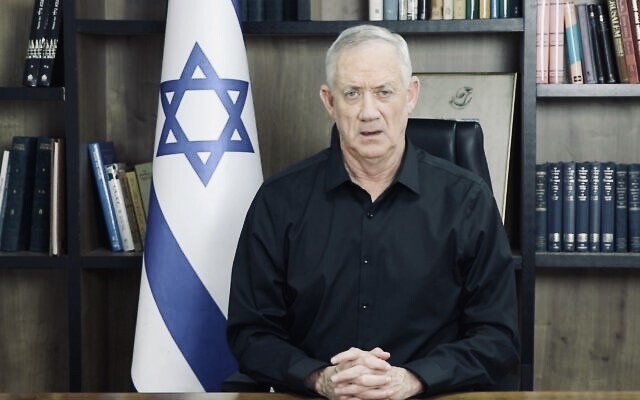What comes after the Israel-Hamas war?
That’s the big unanswered question, even as fighting continues unabated throughout much of the Gaza Strip.
The war started following the October 7 massacre during which Hamas terrorists killed roughly 1,200 Israeli civilians, soldiers and foreign farm workers and kidnapped some 250 people in southern Israel.
But after eight months of intense combat, which has claimed the lives of almost 300 Israeli soldiers and some 13,000 Hamas fighters, Israel has failed to achieve its twin objectives — the defeat of Hamas and the release of all the hostages, one-third of whom may already be dead.
On June 8, Israeli forces rescued four hostages in central Gaza who were abducted from the Supernova music festival, but many more are still in captivity.

Amid this uncertainty, Prime Minister Benjamin Netanyahu has come under constant internal and external pressure to produce a credible and sustainable postwar plan for Gaza’s postwar governance.
In fact, Netanyahu has addressed this burning issue, but not to the satisfaction of either two members of the war cabinet, Benny Gantz and Defence Minister Yoav Gallant, or of the United States, Israel’s chief ally and primary weapons supplier.
Last winter, Netanyahu unveiled a plan that calls for Israeli security control over postwar Gaza and the establishment of a Palestinian civilian administration with no connections to Hamas, which has ruled the coastal enclave since 2006. Netanyahu’s office claimed that his plan “reflects broad public consensus over the goals of the war and for replacing Hamas rule in Gaza with a civilian alternative.”
Netanyahu brushed aside a U.S. proposal for a revamped Palestinian Authority to govern Gaza. And he firmly rejected U.S. President Joe Biden’s call for a two-state solution in the West Bank and Gaza.
The United States was none too pleased by Netanyahu’s response.
Biden administration spokesman said his plan was a prescription for a renewed Israeli occupation of Gaza, from which Israel unilaterally withdrew in 2005.

Claiming he had not seen an Israeli plan for the day after the war in Gaza, U.S. Secretary of State Antony Blinken warned that in its absence Israel would have to occupy Gaza indefinitely and face a Hamas insurgency. By Blinken’s reckoning, Netanyahu’s policy would create a power vacuum likely to be filled by “chaos, anarchy and, ultimately, by Hamas again.”
Biden’s national security advisor, Jake Sullivan, also has been critical of the direction in which Israel appears to be moving. As he said recently, “We’re talking to Israel about how to connect their military operations to a clear strategic end game, about a holistic, integrated strategy to ensure the lasting defeat of Hamas and a better alternative future for Gaza and for the Palestinian people.”
What the Biden administration has in mind is clear. Its objective is to link the incremental formation of Palestinian statehood with Israel’s further integration into the Middle East by means of a historic normalization agreement between Israel and Saudi Arabia.
Since Netanyahu and most of his ministers oppose a two state solution as antithetical to Israel’s fundamental security interests, the grand scheme offered by the Biden administration to remake the Middle East rests on shaky ground.
Be that as it may, Netanyahu realizes that his notion of a postwar Gaza does not converge with two of his most powerful ministers.

On May 18, Gantz, the former minister of defence and the leader of the centrist National Unity Party, handed Netanyahu an ultimatum demanding the release of the hostages, the future governance of Gaza, the return of displaced Israelis in the south and the north to their homes, and the advancement of talks to ensure that Israel can normalize relations with Saudi Arabia.
He gave Netanyahu until June 8 to develop such a plan, but he also said that no one, whether friend or foe, could “impose” a Palestinian state on Israel.
Since the Saudis insist on this key provision, it is unclear how Gantz can reconcile his insistence on a postwar plan with his rejection of Palestinian statehood.
This past January, Gallant called for a proposal under which Israel would maintain military control of Gaza’s borders while a multinational “task force” oversaw reconstruction and economic development in Gaza. During this period, he noted, Palestinians in Gaza who have no ties with Hamas would be in charge of civilian affairs. The Palestinian Authority would have no role in this process.

Three months ago, Gallant shifted his position, saying he could envisage a situation in which local Palestinians affiliated with the Palestinian Authority would govern Gaza. Netanyahu rejected his idea.
As matters stand today, the Israeli government staunchly opposes a leadership role for the Palestinian Authority in Gaza, even though it ruled Gaza from 1993 until 2006 and still continues to conduct security cooperation with Israel in the West Bank.
Israel’s hostile attitude may be predicated, in part, on a comment made by the former prime minister of the Palestinian Authority, Mohammed Shtayyeh. Last December, he expressed hope that Hamas would be a partner in Gaza’s future governance.
Rightly or wrongly, Israel believes that the Palestinian Authority is weak, corrupt and ineffectual. Its geriatric president, Mahmoud Abbas, appointed a new prime minister, Mohammed Mustafa, three months ago to replace Shtayyeh. Mustafa, an economist and political independent, presides over a technocratic government based in Ramallah, but Israel has yet to be convinced that it is capable of ruling Gaza as well.

With the Palestinian Authority apparently out of the picture, Israel may be hard-pressed to maintain full control over Gaza, as Biden administration officials have repeatedly argued.
Israeli forces have been forced to clear and reclear areas of Gaza that were supposedly pacified, and this pattern may manifest itself again and again unless a credible Palestinian civilian government takes charge.
Peter Lerner, an Israeli military spokesman, has acknowledged that Hamas is far from vanquished. “We’re seeing that Hamas still exists, and that they still have capabilities above and beneath ground,” he said recently, noting that its fighters deploy rocket-propelled grenades, small arms and booby traps in attacking Israeli troops.
On June 6, several Hamas fighters killed an Israeli soldier after emerging from a tunnel close near the border. Three of the attackers were killed by Israeli drone and tank fire.

It is clear that Hamas must be militarily crushed and permanently removed as Gaza’s governing authority. But Israel cannot afford to get bogged down in an open-ended insurgency, nor should Israel become its occupying power.
Within these parameters, Israel must find the right path when the war finally ends.
